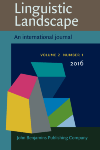
Linguistic Landscape-An International Journal
Scope & Guideline
Illuminating the Role of Language in Everyday Life
Introduction
Aims and Scopes
- Sociolinguistic Analysis of Public Space:
The journal emphasizes the sociolinguistic dimensions of linguistic landscapes, exploring how language use in public spaces reflects and shapes social identities, community dynamics, and cultural narratives. - Semiotic and Multimodal Approaches:
It adopts semiotic frameworks to analyze the visual and textual elements present in the linguistic landscape, investigating how these elements convey meaning and influence perceptions of place. - Political and Activist Dimensions:
The journal highlights the role of linguistic landscapes in political activism and social movements, examining how language in public spaces serves as a medium for protest and expression of dissent. - Translingualism and Multilingualism:
A consistent focus is placed on translingual practices and multilingualism in public signage, investigating how diverse linguistic resources are utilized to negotiate identities and community belonging. - Cultural and Historical Contexts:
The journal often situates linguistic landscapes within their cultural and historical contexts, analyzing how past events and cultural heritage shape contemporary language use in public spaces.
Trending and Emerging
- Impact of COVID-19 on Linguistic Landscapes:
The pandemic has spurred a significant increase in research examining how COVID-19 has transformed public signage and language use, reflecting changing social norms and community responses during health crises. - Gender and Sexuality in Linguistic Landscapes:
There is a growing focus on how gender and sexuality are represented and contested in public spaces, highlighting the intersection of linguistic landscapes with issues of identity and representation. - Environmental and Ecological Perspectives:
Emerging themes also include ecological considerations in linguistic landscapes, as researchers explore how language interacts with environmental issues and public space in the context of sustainability. - Transnational and Diasporic Studies:
An increase in research on transnational and diasporic communities is evident, reflecting the complexities of identity and language in increasingly globalized urban environments. - Digital and Online Linguistic Landscapes:
Scholars are increasingly investigating the role of digital signage and online representations of linguistic landscapes, acknowledging the importance of virtual spaces in shaping public discourse.
Declining or Waning
- Traditional Language Policy Studies:
Research specifically centered on traditional language policy frameworks seems to be less frequent, as scholars increasingly explore more nuanced interactions between language, power, and identity in public spaces. - Static Representations of Linguistic Landscapes:
There is a noticeable decline in studies that solely focus on static representations of linguistic landscapes without considering the dynamic and interactive aspects of language use in public contexts. - Narrow Geographic Focus:
Papers that concentrate exclusively on specific geographic locations without connecting to broader themes of globalization or translocality are becoming less common, reflecting a trend towards more globalized analyses.
Similar Journals
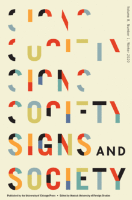
Signs and Society
Engaging with the Nuances of Signs and MeaningSigns and Society is an acclaimed academic journal published by University of Chicago Press, specializing in the interdisciplinary exploration of semiotics, cultural representations, and communication practices. With an impressive ISSN of 2326-4489 and E-ISSN 2326-4497, this journal has established itself as a credible source of research and insight within its fields. It operates under a robust framework with a convergence of topics from 2015 to 2024, and has achieved notable rankings, including Q1 placements in Cultural Studies, Linguistics and Language, and Visual Arts and Performing Arts in 2023, elevating it to a leading status among its peers. The journal’s impact is reflected in its Scopus rankings, positioning it in high percentiles across diverse categories, making it a vital resource for scholars, practitioners, and students interested in the intricate relationships between signs, society, and culture. Although not an open access publication, Signs and Society remains essential for those seeking to deepen their understanding of communication dynamics and the multifaceted dimensions of cultural expression.
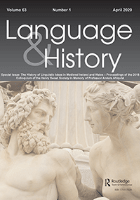
Language & History
Charting the Evolution of Language Across TimeLanguage & History is a distinguished journal published by Routledge Journals, Taylor & Francis Ltd, focusing on the intersection of linguistics and historical context. With an ISSN of 1759-7536 and an E-ISSN of 1759-7544, this journal serves as a vital platform for scholars exploring the dynamic relationship between language evolution and historical narratives. It is recognized for its contributions to the field, holding a Q2 ranking in Linguistics and Language for 2023, reflecting its esteemed position among peer publications. Indexed in Scopus with notable rankings in both Arts and Humanities and Social Sciences, Language & History aims to foster innovative research, shed light on language change, and encourage cross-disciplinary dialogue. The journal operates without open access, providing rigorous peer-reviewed content for researchers, professionals, and students alike, ensuring that cutting-edge studies remain at the forefront of linguistic research. Published biannually, it continues to attract a diverse array of contributions that enrich the understanding of language within historical contexts, making it an essential resource in the academic community.
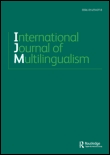
International Journal of Multilingualism
Navigating the rich diversity of human expression.Welcome to the International Journal of Multilingualism, a leading platform dedicated to advancing the field of linguistics and language studies. Established by ROUTLEDGE JOURNALS, TAYLOR & FRANCIS LTD and housed in the United Kingdom, this journal has rapidly ascended to a prestigious Q1 quartile status in both the Linguistics and Language categories as of 2023, ranking in the top 4% across related disciplines. With a remarkable Scopus ranking of #35 in Arts and Humanities and #38 in Social Sciences, it is recognized for publishing high-quality, impactful research that spans a diverse array of multilingual topics. The journal thrives on its commitment to examining the complexities and dynamics of multilingualism in contemporary society, making it an essential resource for researchers, professionals, and students alike. Although Open Access options are not currently available, the journal's rigorous peer-review process ensures that each publication contributes valuable insights into the field. Since its inception in 2004, the International Journal of Multilingualism continues to foster academic discourse and innovation, solidifying its role as a crucial outlet for scholarly work by 2024 and beyond.

Language Dynamics and Change
Innovating Research on Language Variation and ChangeLanguage Dynamics and Change is a premier academic journal dedicated to exploring the evolution, variation, and transformation of languages over time. Published by BRILL, a reputable name in scholarly publishing, this journal aims to provide researchers, professionals, and students with a robust platform for disseminating cutting-edge findings in the field of linguistics. With an impressive Q1 quartile ranking in the Linguistics and Language category and a commendable ranking of #170 out of 1088 in the Arts and Humanities sector, it occupies a significant position in the academic landscape, showcasing innovative research that fosters a deeper understanding of language dynamics. Although it does not currently offer open access, the journal is committed to enhancing accessibility through various distribution channels. As we look ahead to its convergence period extending until 2024, Language Dynamics and Change continues to affirm its status as a vital resource for advancing the study of language evolution worldwide.

Suvremena Lingvistika
Transforming Linguistic Knowledge into Accessible Insights.Suvremena Lingvistika is a distinguished open-access journal published by the Croatian Philological Society, dedicated to advancing research in the field of linguistics and language. Since its establishment, the journal has been pivotal in promoting scholarly dialogue within the linguistics community, especially among researchers and academics in Croatia and beyond. With an ISSN of 0586-0296 and an E-ISSN of 1847-117X, the journal has transitioned to an open-access model since 2007, ensuring that research is freely accessible to all. As of 2023, it holds a respectable Q3 ranking in the Linguistics and Language category, reflecting its potential contribution to the field. The journal's scope encompasses a wide array of linguistic disciplines, encouraging both theoretical and empirical studies. Supportive of new research, Suvremena Lingvistika aims to foster innovative approaches and methodologies in linguistics, making it an essential resource for students, researchers, and professionals eager to explore the complexities of language. With its ongoing publication until 2024, it continues to shape the linguistic landscape, providing valuable insights and fostering collaboration among scholars globally.

Turkic Languages
Unlocking the Secrets of Turkic Language StructuresTurkic Languages is an esteemed academic journal published by HARRASSOWITZ VERLAG, dedicated to the exploration and analysis of Turkic languages within the broader fields of linguistics and language studies. With an ISSN of 1431-4983, this journal serves as a vital platform for researchers, professionals, and students interested in the intricate structures, dynamics, and cultural contexts of Turkic languages. Although it currently operates without an Open Access option, the journal's commitment to quality research is evident in its placement within the Q4 category of Linguistics and Language for 2023, alongside its Scopus rankings where it stands in the 30th and 26th percentiles for Language and Linguistics across Arts and Humanities and Social Sciences, respectively. The journal's scope encompasses a variety of linguistic phenomena, striving to foster a deeper understanding of Turkic languages and their significance in the global linguistic landscape. With converged years from 2017 to 2022, Turkic Languages continues to uphold its reputation as a crucial resource for advancing scholarship in this specialized field.
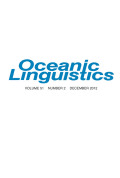
OCEANIC LINGUISTICS
Exploring the Rich Tapestry of Pacific LanguagesOCEANIC LINGUISTICS is a premier academic journal published by UNIV HAWAII PRESS, dedicated to the study of languages spoken in the Pacific region. This esteemed journal, bearing ISSN 0029-8115 and E-ISSN 1527-9421, serves as a vital platform for linguists, researchers, and scholars to disseminate significant findings and insights related to Oceania's rich linguistic diversity. With a commendable impact factor and categorized in the Q2 Quartile for the field of linguistics and language, OCEANIC LINGUISTICS ranks 335th out of 1088 in Arts and Humanities and 395th out of 1167 in Social Sciences, reflecting its relevance and influence in ongoing linguistic discourse. The journal is a subscription-based publication, committed to advancing research and fostering scholarly communication from 2004 to 2024, making it an essential resource for anyone engaged in the study of linguistic phenomena in the Oceania region and beyond.
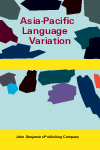
Asia-Pacific Language Variation
Exploring the Rich Tapestry of Asia-Pacific LinguisticsAsia-Pacific Language Variation is a prominent scholarly journal published by John Benjamins Publishing Co, dedicated to the exploration and analysis of linguistic diversity across the Asia-Pacific region. With its ISSN 2215-1354 and E-ISSN 2215-1362, the journal serves as a key resource for researchers and practitioners in the fields of linguistics and language studies. Since its inception in 2019, it has quickly ascended in stature, receiving a 2023 category quartile ranking of Q2 in Linguistics and Language and achieving impressive Scopus rankings, placing it in the 83rd percentile in Arts and Humanities and 81st in Social Sciences. Through its rigorous peer-reviewed articles, the journal aims to foster a deeper understanding of language variation, promoting interdisciplinary research and collaboration. Although it is not an open-access journal, the depth of research and critical insights offered in its pages make it an invaluable asset for academics, students, and professionals keen on the nuances of language within the dynamic Asia-Pacific context.
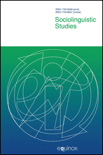
Sociolinguistic Studies
Advancing Knowledge in Sociolinguistic PhenomenaSociolinguistic Studies, published by EQUINOX PUBLISHING LTD, is a premier academic journal dedicated to advancing the understanding of language in its social context. With an ISSN of 1750-8649 and an E-ISSN of 1750-8657, this journal plays a vital role in the fields of linguistics, sociology, and political science, offering a platform for interdisciplinary research that bridges diverse theoretical frameworks and methodologies. Since its inception in 2008, the journal has remained committed to publishing high-quality research that contributes to the critical engagement with sociolinguistic phenomena globally. With a categorization of Q3 in both Linguistics and Language and Sociology and Political Science as of 2023, and notable Scopus rankings reflecting its intellectual contribution, Sociolinguistic Studies is essential for researchers, professionals, and students aiming to explore the intricate relationships between language, society, and identity. Although open access is not currently available, the journal's scholarly impact continues to grow as it shapes contemporary discussions in sociolinguistics through rigorous peer-reviewed articles.

Studia z Filologii Polskiej i Slowianskiej
Connecting Cultures Through Language and LinguisticsStudia z Filologii Polskiej i Slowianskiej is a prominent journal published by the Polish Academy of Sciences, Institute of Slavic Studies, focusing on the rich and diverse field of linguistics and language studies, particularly within the Slavic context. With the ISSN 0081-7090 and E-ISSN 2392-2435, this open-access journal has been a valuable resource for researchers, professionals, and students since its transition to an open-access model in 2014. It features rigorous peer-reviewed articles that contribute to the understanding of linguistic phenomena and cultural narratives across Slavic languages. Recognized within the Q3 quartile of linguistics and language in 2023, it ranks at the intersection of arts, humanities, and social sciences, providing insights that echo through disciplines such as sociolinguistics, psycholinguistics, and philology. In its ongoing publication trajectory from 2011 to 2023, Studia z Filologii Polskiej i Slowianskiej continues to foster academic discourse and collaboration, positioning itself as a key player in the global linguistic community.